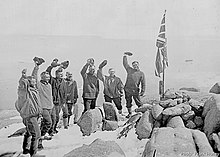Proclamation Island
| Proclamation Island | ||
|---|---|---|
| Waters | Cosmonaut Lake | |
| Geographical location | 65 ° 51 ′ S , 53 ° 41 ′ E | |
|
|
||
| Highest elevation | 245 m | |
| Residents | uninhabited | |
Proclamation Island is a small, rocky island off the coast of Enderbyland in East Antarctica . It is about 2.5 nautical miles west of Cape Batterbee , west of the island are the Aagaard Islands .
history

The island was discovered by the British Australian and New Zealand Antarctic Research Expedition under Sir Douglas Mawson on board the Discovery . The expedition was looking for a possible landing site on the coast of the continent. However, since there was no such place on the coast due to the high ice wall, they turned to this island. Ten men of the expedition rowed a boat to the island on January 13, 1930 and Mawson was the first to set foot on the island. On the 245 m high summit of the island they built a stone mound for a flagpole, on which they hoisted the Union Jack to take possession of this region of the Antarctic continent for the British crown. On the occasion, Mawson recited an official proclamation of possession from memory (since the document had, by mistake, been prematurely buried in a metal canister on the flagpole). The island was named Proclamation Island ("Proclamation Island") because of this announcement.
Following a suggestion from Australia, the cairn and a plaque that had been placed there by the expedition members were added to the list of historical sites and monuments in Antarctica in 1972.
fauna
Penguins and various other bird species live and breed on the island . According to reports by the British Australian and New Zealand Antarctic Research Expedition and participating ornithologist RA Falla, there were large breeding colonies of Adelie penguins on the island in the 1930s . The researcher J. Cooper, who visited the island in 1985, found only one colony, which he estimated to be about 5,000 Adelie penguins. The expedition also reported on snow petrels ( Pagodroma nivea ), Antarctic petrels ( Thalassoica antarctica ), Cape petrels ( Daption capense ), silver petrels ( Fulmarus glacialoides ), blue- footed petrels ( Oceanites oceanicus ) and Antarctic kuas ( Starfish kuas ).
In 1978, researcher DS Horning discovered specimens of the beetle species Bountya insularis on the island.
literature
- Christy Collis: The Proclamation Island moment: making Antarctica Australian (PDF; 70 kB) . In Law Text Culture Volume 8, Issue 1. 2004. ISSN 1322-9060 , pp. 39-56
Individual evidence
- ^ Proclamation Island ( English ) In: Geographic Names Information System . United States Geological Survey . Retrieved December 7, 2010.
- ^ Christy Collis: The Proclamation Island moment: making Antarctica Australian . In: Law Text Culture . tape 8 , no. 1 , 2004, p. 39–56 ( edu.au [PDF; accessed December 7, 2010]).
- ↑ Antarctic Treaty Secretariat: List of Historic Sites and Monuments approved by the Antarctic Treaty Consultative Meeting (PDF; 107 kB) . Retrieved December 7, 2010.
- ^ J. Cooper: Adelie penguins breeding in Eastern Enderby Land, Antarctica . In: Emu . tape 85 , no. 3 , 1985, pp. 205–206 , doi : 10.1071 / MU9850205 ( csiro.au [PDF; accessed December 7, 2010]).
- ↑ James Ian Townsend: Larva of Bountya insularis Townsend (Coleoptera: Carabidae) . In: New Zealand Entomologist . tape 11 , 1988 ( org.nz [PDF; accessed December 7, 2010]). Larva of Bountya insularis Townsend (Coleoptera: Carabidae) ( Memento of the original from October 17, 2008 in the Internet Archive ) Info: The archive link was inserted automatically and has not yet been checked. Please check the original and archive link according to the instructions and then remove this notice.
